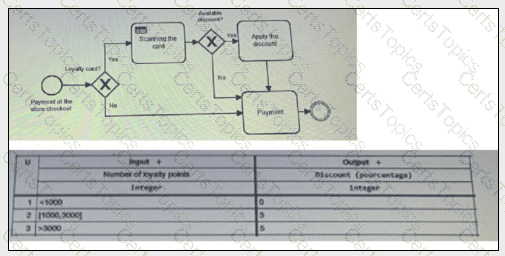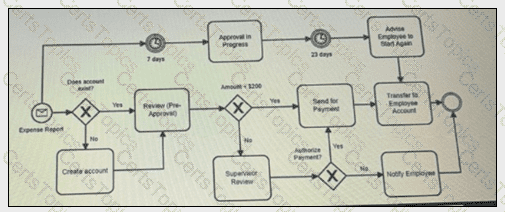Which one of the following test design techniques fits accepting testing purposes BEST?
How are beta testing and acceptance testing related?
In a project to develop an online booking system, the team decided to strengthen collaborative work between the business analyst and the testers working on the project. Several concrete joint activities have been identified.
What is considered as good practice regarding business process modeling?
Which of the following pillars of UX requirement analysis is described BEST?
The following BPMN and DMN models are used for acceptance testing. The DMN table is linked to the credit card scanning to check if a discount is applicable.
Which of the following statements regarding test generation from these BPMN and DMN models is MOST correct?

As a part of a travel expense reimbursement management system, the following business process is defined:
• After receipt of the expense report, a new account must be created if the employee does not already have one. The report is then reviewed.
• Amounts less than $200 are automatically approved, while amounts equal to or greater than $200 must be approved by the supervisor. If the request is rejected, the employee is informed. The employee is reimbursed by payment to his of her bank account.
• If the request is not processed within 7 days, the employee receives an "ongoing" e-mail. If the request is not completed within 30 days, then the process is stopped, and the employee receives a cancellation e-mail asking her/him to resubmit the refund request
The following BPMN model has been submitted for review
Which of the following comments is MOST Likely to have been made on this BPMN model?

Which of the following provides the BEST description of Beta testing?
On a project to develop an event booking platform, a review session is being conducted on acceptance test cases written in Ghenkin's language. Consider the following test case:
1. GIVEN I am logged in on the event booking platform
2. AND I have selected an event from the list displayed for the "live concert" category
3. WHEN I click "Buy Tickets" buttom
4. AND I enter "3" into "Ticket quantify" field
5. AND I agree on terms and conditions
6. THEN The system should display the checkout page
7. AND I should provide my personal data for payment and eticket delivery
Which of the following sentences MOST closely corresponds to a comment that could be made on this test case during the review?
The project team is currently facing a difficult situation originating from their difficulty in envisioning the future and the necessary steps to reach it together with a certain loss of motivation due to a strong feeling of stagnation. You try to unlock the situation by proposing a workshop. Which one would fit the best?
As a tester on an Agile project, you have to perform an exploratory test session for a new feature developed. Which of the following actions is the LEAST likely to be carried out for the purpose.
Your company wants to establish a new human resources management application. As tester, you propose to use an ATDD approach and to use business process models for test case design.
Which of the following statements is the LEAST meaningful argument for this approach?
A green courier working for an urban delivery service company uses three types of vehicles: normal bicycles, electric cargo bikes and electric vans. The following DMN table provides the rules used to select the type of zero emission vehicle to be used according to the weight (in kg) and the largest dimension (in cm) of the parcel, and the delivery distance (in km)
Which one of the following statements is consistent with this DMN table?

As a tester you are part of a development team for a health monitoring system to record and synchronize various health parameters, calculate health score and provide practical advice on how to maintain and improve health Consider the following User Story and related acceptance criterion:
US 34: As a user of the system, I can measure my blood sugar by using a blood glucose meter connected device, in order to adjust my diet and medication dosage if I am diabetic
Acceptance criteria # 1 - Once a blood sugar measurement using the blood glucose meter is done by logged-in user, the measurement result is displayed in less than four seconds.
Which of the following test cases written in Gherkin language is BEST for this user story and acceptance criterion?
Which of the following report formats fits the intended audience BEST?
Which one of the following acceptance criteria relates to security requirements?
As an acceptance tester you are analyzing the following user story for a computer web-based mass multiplayer role-playing game:
As an unregistered player
I want to be able to register myself by defining my e-mail, login and password in a registration form so that I become a registered player
Consider the following propositions of the acceptance criteria:
i.a registration form is displayed on the screen.
ii.the form is written in the Groovy language; the cursor is initially set on the ‘login’ field; after pushing the TAB button the cursor switches to ‘password’, ‘repeat password’, ‘mail’, and ‘repeat mail’ forms.
iii.I cannot register myself if the login I choose is used by another player.
iv.after successful registration process I am informed about it by an e-mail.
Which of the above statements would you consider as well-written acceptance criteria?
Which one of the following statements regarding performance testing is MOST correct?
As an acceptance tester you want to test the $100 withdrawal process described by the following BPMN model.

You would like to achieve decision coverage. Consider the following test cases: Test 1: balance = $100, receipt = YES
Test 2: balance = $99
Test 3: balance = $120, receipt = NO Test 4: balance = $2500, receipt = YES
Which of the following is the minimal set of test cases allowing to achieve full decision coverage?
Which one of the following statements regarding acceptance criteria is true?
Which one of the following statements regarding the quality of requirements is MOST correct?
The standard ISO 25010 defines a quality in use model with characteristics and subcharacteristics. Which elements of the following list is a characteristic of quality in use according to this standard?
Which one of the following scenarios characterizes UX task analysis BEST?
Which one of the following statements BEST explains how the quality of requirements / user stories and acceptance criteria affects acceptance testing?